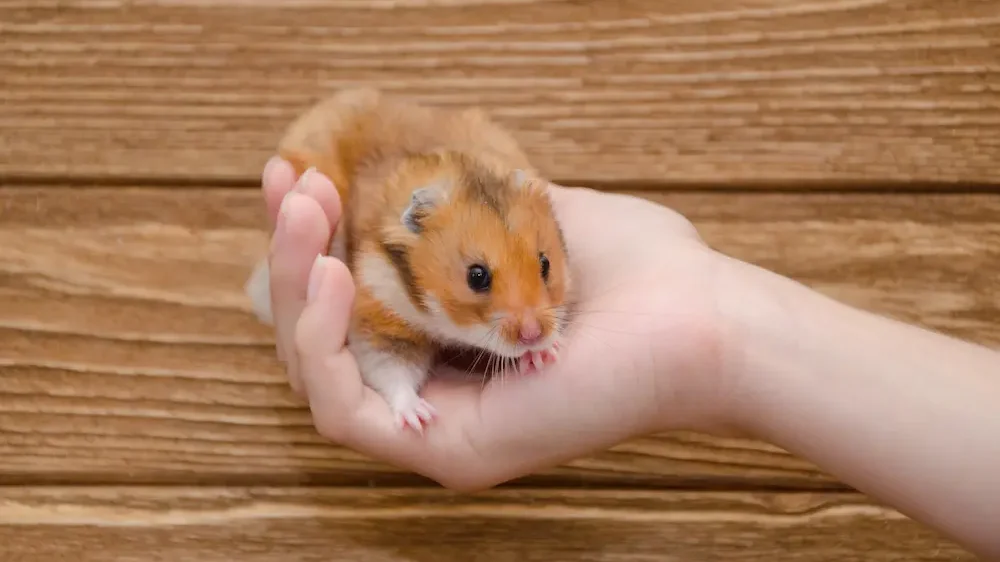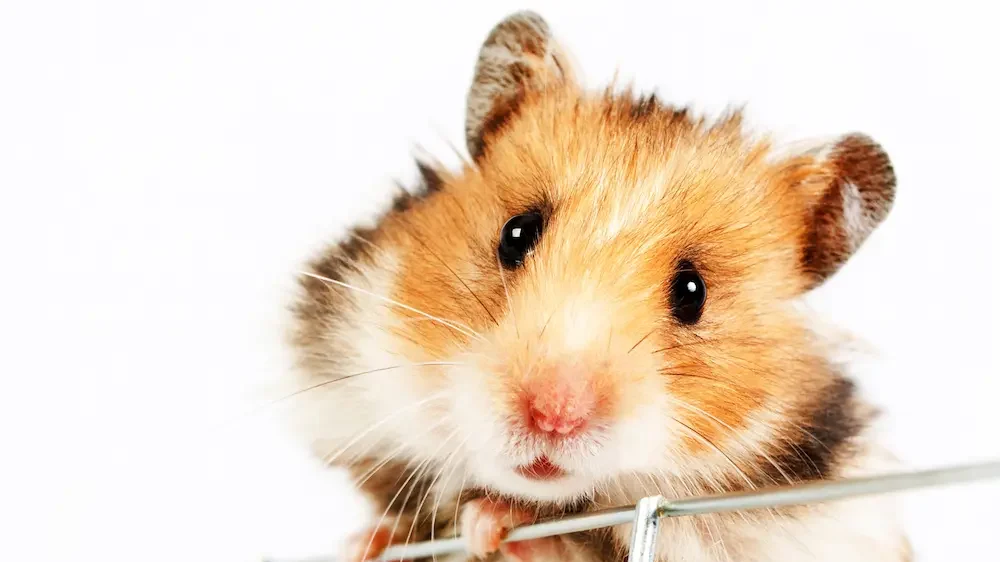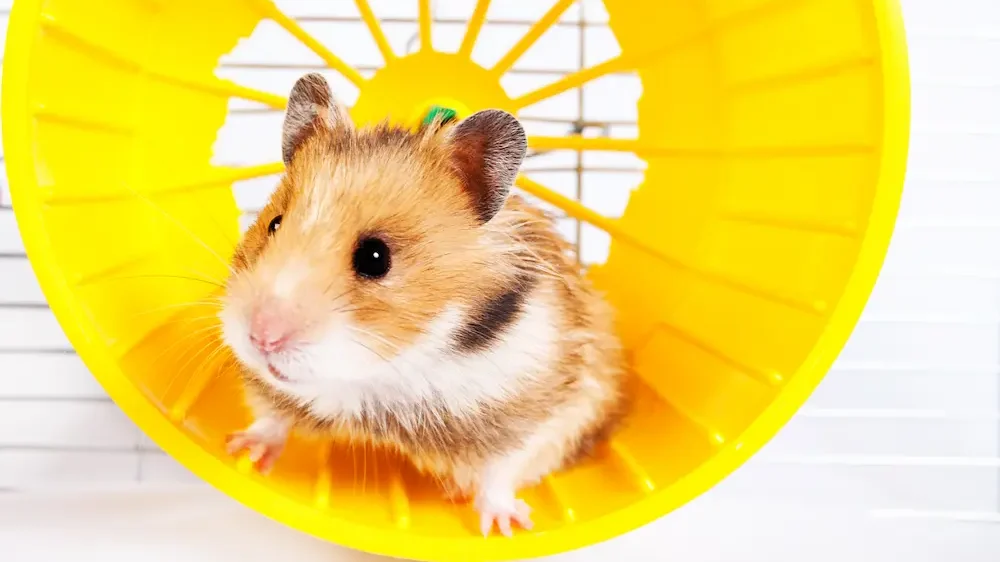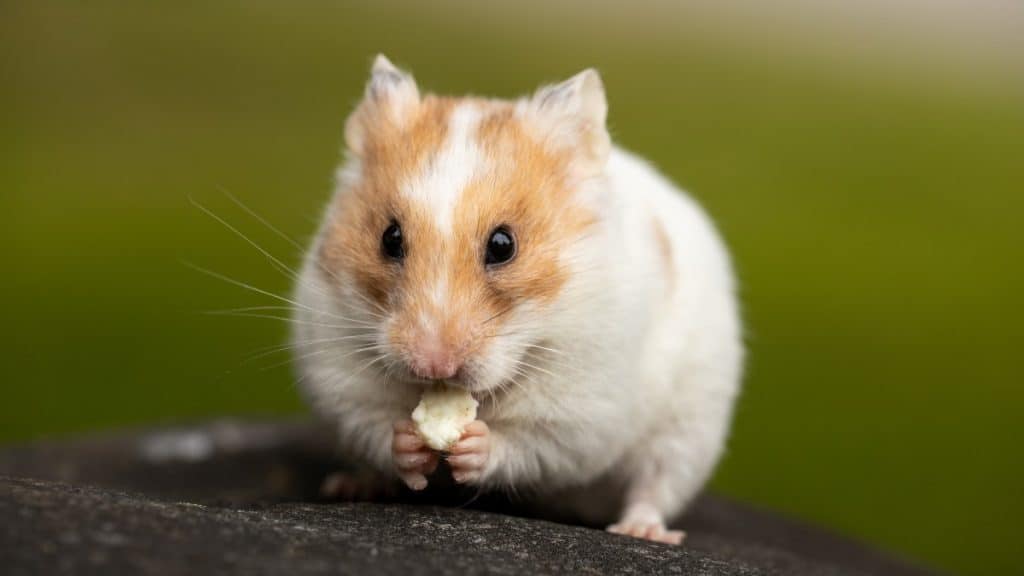Table Of Contents
The teddy bear hamster is one of the most popular pets among small mammal enthusiasts, especially in the United States.
If you are looking for a furry friend for you or for your children, or if you already own one of these delightful little animals, read on for more information.
What Is A Teddy Bear Hamster?
A teddy bear hamster is one of several names for a Syrian hamster. Other names include Golden hamster, fancy bear hamster, short hair hamster, bear hamster, and angora hamster.
This species of hamster is the most common in the world. The scientific name for this type of rodent is Cricetinae.

What Does A Teddy Bear Hamster Look Like?
As you might expect from its name, most folks would say that it looks like a cuddly teddy bear.
These small animals have beautiful dark eyes. Their round, stocky bodies are covered with thick, soft fur that culminates in a fluffy little tail that is often hidden amid its fur. They can have short or long hair.
Their ears are distinctively shaped like a tulip. They have short, stubby legs and feet.
Adults will usually be no longer than 5-7 inches (13 to 18 cm) and weigh no more than 4 ounces (113 gms).
What Color Is The Fur On Teddy Bear Hamsters?
Most teddy bear hamsters have short, silky, golden brown fur, but they come in about 40 different colors.
A search of your local pet store might discover colors like gray, black, yellow, chocolate, or cinnamon.
Whatever color you find, you’ll also find that most often their bellies are white.
How To Tell The Sex Of A Teddy Bear Hamster?
You might be interested to learn that:
- Male hamsters are called boars.
- Female hamsters are called sows.
- Baby hamsters, regardless of their sex, are called pups.
It is important to know the sex of your pet hamster because if you have more than one you will want to separate males from females to avoid unwanted pregnancies.
Hamsters typically reach maturity when they are about six weeks old, so that is when it is easiest to examine your pet to spot whether it’s male or female. Here’s how you do it:
- If your hamster is tamed and comfortable in your hand, gently cup it in your palm and then roll it over onto its back. In this position, a hamster will typically spread its legs so that you can take a look at what is between its legs.
- If your hamster is very young or doesn’t like to be held this way, you can alternatively place it in a clear plastic container or travel case and then hold it over your head so that you can see your pet’s underside.
Once you have the hamster properly positioned, here is what to look for:
Males
- Male hamsters obviously have a penis, and their testicles are often very pronounced and easy to spot. Hamsters can retract their testicles when they are too cold or too anxious, so you can’t always count on spotting them right off the bat.
- Other than visual examinations while holding your hamster, you may also observe that your male hamster tends to groom himself in this area.
- Male hamsters will also tend to have fur around their genitalia.
- Male hamsters are usually a bit smaller than females and have narrower behinds, which can make them appear slightly elongated.
Females
- Female hamsters have six sets of nipples, whereas their male counterparts have none. Because of the thick, luxurious fur that you will find on your hamster, it can be challenging to find the nipples.
- Female hamsters tend to have no fur around their genitalia.
- Female hamsters tend to have more rounded behinds.

Why Is A Teddy Bear Hamster A Good Pet?
It is not surprising that hamsters are among the most popular pets in the world. Here are a few reasons why:
- They are great for kids and adults. They are friendly and, unlike many other pets, they love to interact with their owners.
- They have a reasonable lifespan. Domestic teddy bear hamsters have an average lifespan of about three years. That’s a shorter commitment than pets like dogs or cats.
- They are small. These diminutive furballs are easy to handle and don’t take up very much space.
- They are easy to care for. It is fun and easy to set up their homes, their food is readily available, and they don’t require an extraordinary amount of maintenance.
- They have fabulous personalities. They love to be held and played with, and they also enjoy being let out of their cages to run around and explore.
- They come in a bunch of colors. With such variety, you can own a teddy bear hamster that doesn’t necessarily look like everyone else’s.
- They are solitary souls. They love to play and to be held, but they also like a lot of time by themselves. Consequently, they aren’t too demanding or always begging for attention.
- They are nocturnal. Teddy bear hamsters like to play and be active at night. That doesn’t mean that you can’t play with them during the day, but it does mean that they enjoy sleeping away their days while their owners are away all day at school or at work.
- They have cool houses. Hamster houses are typically aquariums, which come in various shapes and sizes. And you can be a creative interior designer as you determine the most entertaining and comfortable interior. Just remember that bigger is better because hamsters love to burrow and roam and climb.
- They are affordable. Sometimes you can adopt a hamster for free, but usually, you should expect to pay around $20 for a pet store teddy bear hamster. Your initial outlay will also include your choice of aquariums or hamster cages, water bottles, an exercise wheel, and whatever material you choose to use for bedding. After paying for your pet and its housing, you will have few ongoing expenses because the food is inexpensive. Gift cards from or to friends or children can make getting started a snap.
Do They Bite?
Hamsters are generally docile, delightful pets when they are properly acclimated and handled. But, yes, on rare occasions they might bite. Their bites are usually harmless, but they can be a little painful.
Why Would They Bite?
Hamsters are prey animals and so they are naturally always on the defensive to protect themselves. They might bite you if they are frightened or startled or if they are in pain.
You can help avoid the risk of being bitten by following these simple rules:
- Don’t pick up your pet when it is sleeping. Instead, wake your hamster with your voice rather than your fingers.
- Don’t reach for your hamster from behind.
- Handle your hamster often and gently – familiarity breeds contentment and security.
- Wash your hands before picking up your hamster so that there are no confusing food odors that might cause it to mistake you for a tasty morsel.
Do’s And Don’ts If Your Hamster Bites
Here are some guidelines to follow in case your hamster bites:
- DO clean the wound. You can use warm water and some antibacterial soap. Once it is dry, apply a loose bandage.
- DO take a look at the wound over the next two days to make sure that any possible swelling has gone down. If it is still swollen, it is time to see your doctor or urgent care facility to get some antibiotics.
- DON’T try to shake your hamster to get it to let go. All you have to do is gently lower your hamster into its home and then slowly free your hand.
- DON’T shout at your pet to let go. If you raise your voice suddenly, you will most likely frighten the hamster and provoke him to bite again.
The good news is that because your pet is kept inside your home there is little chance that anyone it might bite will catch any disease. Even though a bite may be painful, you probably don’t have to worry about it.
What Do Teddy Bear Hamsters Eat?
It is important that your hamster always has fresh, clean water to drink and good, quality food to eat.
Teddy bear hamsters usually eat only about 2 tablespoons of food a day. They don’t just keep eating because food is available. Instead, they take any excess food and put it into storage by tucking it into a corner of their cage or burying it.
Hamsters have cheek pouches that they use to store and transport food. These pouches can expand to make their heads appear two or three times the normal size.
The largest portion of your hamster’s diet should be commercially available, inexpensive pellets that are specially formulated for hamsters. These are also good food for gerbils and other rodents.
Exercise caution if you choose to select expensive seed mixes because these often contain a lot of fat that can lead to poor nutrition and obesity.
Hamsters enjoy fruits and vegetables, too. A word of caution here – moderation is the key. If you give your hamster too much fruit and vegetables, it can become obese.
Hamsters also like to nibble on hay to aid with digestion, although hay isn’t an essential part of their diets.

How To Set Up A House For My Hamster?
Here are the main things to consider when you create a home for your teddy bear hamster:
- Living arrangements. You might think it is a good idea to get two hamsters so that your pets have a pal to play with. Bad idea. Hamsters are solitary animals, so you should not put more than one in a cage. If you have more than one hamster, give each a separate home.
- Cages. Hamsters love to chew, so choose cages that are constructed with wire, glass, durable plastic, or stainless steel and have sturdy solid bottoms. Fish aquariums are very popular because of the variety of shapes and sizes.
- Bedding. Aspen shavings are ideal for bedding and nesting. Stay away from cedar shavings, corncob, or pine shavings. Don’t be shy with this stuff – 8 to 10 inches deep is good because hamsters love to burrow, and deep bedding will make them happy and healthy.
- Water bottle. Clean, fresh water is essential.
- Food bowl. A small bowl that doesn’t take up too much space is the best.
- Exercise wheel. In the wild, hamsters wander for miles every day. Wheels give them an opportunity to release all that energy while in a confined space.
- Toy. You will find a number of cute and entertaining toys like corrugated tunnels, chew toys, and suspension bridges at your local pet store.
- Hideaway. Your hamster will also enjoy a little getaway house where it can hide from the world instead of burrowing.
How To Maintain My Hamsters Habitat?
There isn’t a lot of maintenance with hamsters. Here’s all you have to do:
- Every day: Remove any dirty bedding material. Hamsters tend to urinate in the same spots, usually corners, so that’s the material to remove. Also, wash the food dish and refresh the water bottle.
- Every week: Change out all of the bedding including removing any food that has been buried.
- Every month: Wash the entire habitat. Put 2 tablespoons of antibacterial soap or white vinegar or bleach in a spray bottle and spray the entire cage. Spray everything in the cage, too.
Summary And Conclusion
Domestic teddy bear hamsters are cute, cuddly, and an ideal hamster breed for both adults and children.
They rank among the most popular pets because they are small, affordable, easy to care for, playful, entertaining, and love to be held.
Their food is readily available and inexpensive. Once you purchase the pet and create a home for it, there is hardly any ongoing expense.
They have reasonable life spans, usually around 2 to 3 years if they are properly cared for. This is long enough to provide years of enjoyment without having to make the long-term commitment that is required with dogs or cats.
FAQs
How long is the gestation period of a teddy bear hamster?
The gestation period of a teddy bear hamster is approximately 16 days.
What is the age of sexual maturity?
The age of sexual maturity for a teddy bear hamster is 6 months.
Are There Any Syrian Hamsters Living In The Wild?
There are Syrian hamsters still living in the wild however they are endangered.
References
- https://www.petco.com/shop/AjaxContentNavResultView?contentPath=%2Fcontent%2Fpetco%2FPetcoStore%2Fen_US%2Fpet-services%2Fresource-center%2Fnew-pet%2F25-fun-facts-about-hamsters.html&catalogId=10051&langId=-1&storeId=10151
- https://www.medvetforpets.com/hamster-information-care-recommendations/

